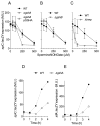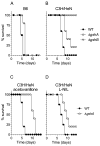Low-molecular-weight thiol-dependent antioxidant and antinitrosative defences in Salmonella pathogenesis
- PMID: 23217033
- PMCID: PMC3885168
- DOI: 10.1111/mmi.12119
Low-molecular-weight thiol-dependent antioxidant and antinitrosative defences in Salmonella pathogenesis
Abstract
We found herein that the intracytoplasmic pool of the low-molecular-weight (LMW) thiol glutathione (GSH) is readily oxidized in Salmonella exposed to nitric oxide (NO). The hypersusceptibility of gshA and gshB mutants lacking γ-glutamylcysteine and glutathione synthetases to NO and S-nitrosoglutathione indicates that GSH antagonizes the bacteriostatic activity of reactive nitrogen species. Metabolites of the GSH biosynthetic pathway do not affect the enzymatic activity of classical NO targets such as quinol oxidases. In contrast, LMW thiols diminish the nitrosative stress experienced by enzymes, such as glutamine oxoglutarate amidotransferase, that contain redox active cysteines. LMW thiols also preserve the transcription of Salmonella pathogenicity island 2 gene targets from the inhibitory activity of nitrogen oxides. These findings are consistent with the idea that GSH scavenges reactive nitrogen species (RNS) other than NO. Compared with the adaptive response afforded by inducible systems such as the hmp-encoded flavohaemoprotein, gshA, encoding the first step of GSH biosynthesis, is constitutively expressed in Salmonella. An acute model of salmonellosis has revealed that the antioxidant and antinitrosative properties associated with the GSH biosynthetic pathway represent a first line of Salmonella resistance against reactive oxygen and nitrogen species engendered in the context of a functional NRAMP1(R) divalent metal transporter.
© 2012 Blackwell Publishing Ltd.
Conflict of interest statement
The authors have no conflict of interest.
Figures








Similar articles
-
Thiolation and nitrosation of cysteines in biological fluids and cells.Amino Acids. 2003 Dec;25(3-4):323-39. doi: 10.1007/s00726-003-0020-1. Epub 2003 Aug 21. Amino Acids. 2003. PMID: 14661094 Review.
-
Cytochrome bd-Dependent Bioenergetics and Antinitrosative Defenses in Salmonella Pathogenesis.mBio. 2016 Dec 20;7(6):e02052-16. doi: 10.1128/mBio.02052-16. mBio. 2016. PMID: 27999164 Free PMC article.
-
Redox active thiol sensors of oxidative and nitrosative stress.Antioxid Redox Signal. 2012 Nov 1;17(9):1201-14. doi: 10.1089/ars.2012.4522. Epub 2012 Mar 15. Antioxid Redox Signal. 2012. PMID: 22257022 Free PMC article. Review.
-
Superoxide modulates the oxidation and nitrosation of thiols by nitric oxide-derived reactive intermediates. Chemical aspects involved in the balance between oxidative and nitrosative stress.J Biol Chem. 1997 Apr 25;272(17):11147-51. doi: 10.1074/jbc.272.17.11147. J Biol Chem. 1997. PMID: 9111012
-
Non-protein thiols flux to S-nitrosothiols in endothelial cells: an LPS redox signal.Shock. 2000 Aug;14(2):200-7. doi: 10.1097/00024382-200014020-00021. Shock. 2000. PMID: 10947167
Cited by
-
Zinc-dependent substrate-level phosphorylation powers Salmonella growth under nitrosative stress of the innate host response.PLoS Pathog. 2018 Oct 26;14(10):e1007388. doi: 10.1371/journal.ppat.1007388. eCollection 2018 Oct. PLoS Pathog. 2018. PMID: 30365536 Free PMC article.
-
Pseudomonas aeruginosa glutathione biosynthesis genes play multiple roles in stress protection, bacterial virulence and biofilm formation.PLoS One. 2018 Oct 16;13(10):e0205815. doi: 10.1371/journal.pone.0205815. eCollection 2018. PLoS One. 2018. PMID: 30325949 Free PMC article.
-
Burkholderia pseudomallei Evades Nramp1 (Slc11a1)- and NADPH Oxidase-Mediated Killing in Macrophages and Exhibits Nramp1-Dependent Virulence Gene Expression.Front Cell Infect Microbiol. 2017 Aug 8;7:350. doi: 10.3389/fcimb.2017.00350. eCollection 2017. Front Cell Infect Microbiol. 2017. PMID: 28848712 Free PMC article.
-
The Effectors and Sensory Sites of Formaldehyde-responsive Regulator FrmR and Metal-sensing Variant.J Biol Chem. 2016 Sep 9;291(37):19502-16. doi: 10.1074/jbc.M116.745174. Epub 2016 Jul 29. J Biol Chem. 2016. PMID: 27474740 Free PMC article.
-
Increased S-nitrosylation and proteasomal degradation of caspase-3 during infection contribute to the persistence of adherent invasive Escherichia coli (AIEC) in immune cells.PLoS One. 2013 Jul 4;8(7):e68386. doi: 10.1371/journal.pone.0068386. Print 2013. PLoS One. 2013. PMID: 23861899 Free PMC article.
References
-
- Ables GP, Takamatsu D, Noma H, El-Shazly S, Jin HK, Taniguchi T, Sekikawa K, Watanabe T. The roles of Nramp1 and Tnfα genes in nitric oxide production and their effect on the growth of Salmonella typhimurium in macrophages from Nramp1 congenic and tumor necrosis factor-alpha−/− mice. J Interferon Cytokine Res. 2001;21:53–62. - PubMed
-
- Baker MA, Cerniglia GJ, Zaman A. Microtiter plate assay for the measurement of glutathione and glutathione disulfide in large numbers of biological samples. Anal Biochem. 1990;190:360–365. - PubMed
-
- Bang IS, Liu L, Vazquez-Torres A, Crouch ML, Stamler JS, Fang FC. Maintenance of nitric oxide and redox homeostasis by the salmonella flavohemoglobin hmp. J Biol Chem. 2006;281:28039–28047. - PubMed
Publication types
MeSH terms
Substances
Grants and funding
LinkOut - more resources
Full Text Sources

